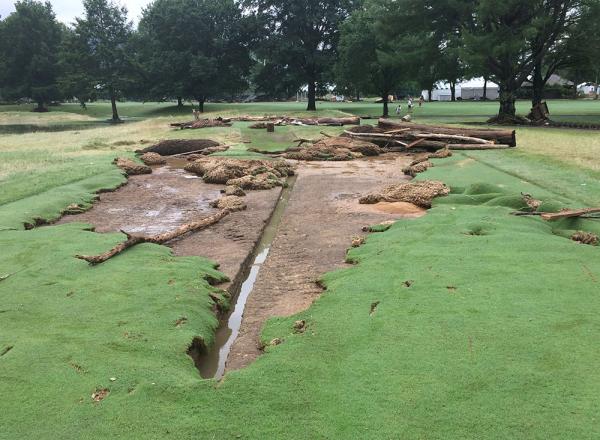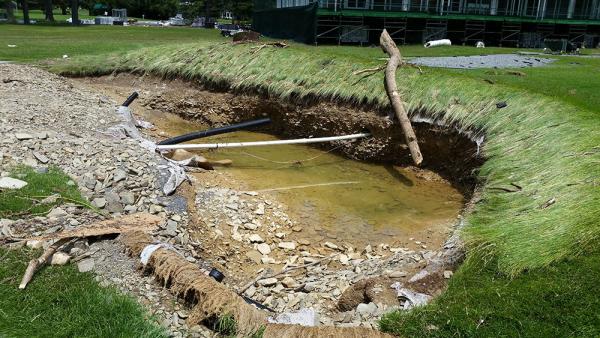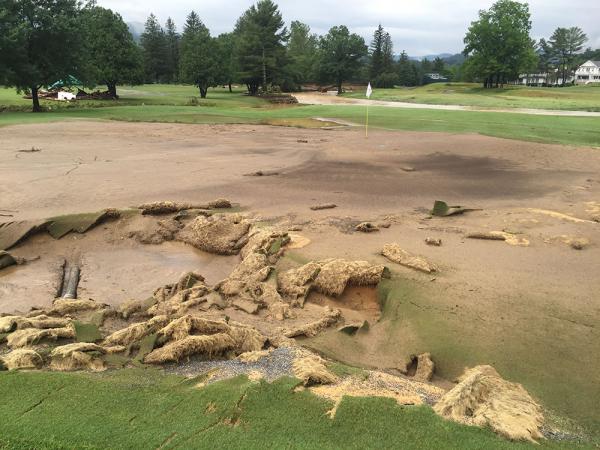The events of June 23, 2016 will forever be part of Josh Pope's career, even if he is trying to forget much of what happened that day. What occurred during the following 12 months has defined his career.
 When deadly floodwaters early last summer washed out the Old White course at The Greenbrier Resort in White Sulphur Springs, West Virginia and the PGA Tour event that was to be played there, Pope played a key role in leading a revival of the 100-year-old layout and the tournament.
When deadly floodwaters early last summer washed out the Old White course at The Greenbrier Resort in White Sulphur Springs, West Virginia and the PGA Tour event that was to be played there, Pope played a key role in leading a revival of the 100-year-old layout and the tournament."People asked how I did it," said the 38-year-old Pope.
"It's the rigors of our job."
"Josh was fantastic to work with," said golf course architect Keith Foster, who was called upon to map out, on the fly, a plan to rebuild the course. "Such a talented guy and committed to our success."
Early that June morning, rain greeted The Greenbrier Resort, where Pope had been in his current position as head superintendent of the Old White course for about a year-and-a-half and was just days away from hosting a PGA Tour event. Or so he thought at the time.
As the rain fell harder and harder, Pope's initial concerns were merely how the downpour would affect the final run-up to the tournament scheduled for July 4-10.
"We just tried to get through mowing and topdressing because we were 10 days out from the tournament," Pope said. "It continued to rain off and on, and it became too wet to do anything, so by 10 a.m. we closed the course and I sent the staff home."
His outlook changed when the storm, that began as a mere nuisance turned the normally benign Howard's Creek into a raging torrent that eventually was blamed for the deaths of nearly two-dozen people.
"It kept raining and raining. I was watching the radar, and it was just band after band of rain on top of us," Pope said. "The creek kept rising and rising. I thought it was going to stop, but it didn't. It kept raining until the creek came out of its banks."
It wasn't long before the overflowing creek had swamped many parts of the golf course, including parts of U.S. 60 that cuts through the property and the tunnels running underneath it that connect the maintenance facility to the rest of The Greenbrier.
"Until then, I was just thinking about the golf course. Then I saw the 15th green went under water and I realized we we were going to be in trouble," Pope said. "When I tried to get back to the maintenance facility, I was thinking 'this is going to end well.' By then, I wasn't thinking about the golf course any more.
"I was driving down 60 trying to get to the road to the maintenance facility, and that was kind of scary," Pope said. "Cars were hydroplaning on the road. It was like a scene out of a movie. I called (assistant superintendent) Chris (Anderson) at the clubhouse and told him not to even try to get back to the shop."
He would have been stranded there if not for Kelly Shumate, director of golf course maintenance at Greenbrier's three courses, who made his way to the maintenance shop in a four-wheel-drive truck.
Fortunately, I never saw that, but I'm trying to forget it happened."
It wasn't until the next day, when the water had receded that Pope and his crew, along with the teams from the resort's Meadows and Greenbrier courses, could get out to assess damage. It was clear right away that the PGA Tour event wasn't going to happen.
High water marks exceeded 6 feet in some areas. A marker noting the depth of a 1915 flood near the 14th green and 15th tee on the 1914 Charles Blair Macdonald design was 8 feet under water.
By the following day, it was clear it would be impossible to stage a PGA Tour event within 10 days, and that the focus needed to be on recovery.
The property's entire golf staff, including teams from the Greenbrier, Meadows and Old White courses as well as golf shop, paired up in teams of two and walked the entire property to assess damage.
"We documented every single thing. We took pictures and we wrote everything down," Pope said. "For two days, we documented everything that had been destroyed or not damaged.
"The million-dollar question was 'Where do we start? What do we do?"
The irrigation system didn't work and there were multiple breaks scattered throughout the property. A fuel tank from an unknown residence came to rest on the course and leaked diesel into the irrigation pond.
"I don't know where that came from," Pope said. "And I didn't know what was in that water."
Half the greens on the course were covered in silt. Everything that was under water the day before now was carpeted in mud up to a foot-and-a-half thick and dead fish from a nearby hatchery upstream.
Sod on teeing areas was rolled up like discarded carpet and drainage tiles had been ripped from the ground. Emergency first responders recovered the bodies of three flood victims from the golf course, including a 14-year-old boy whose remains were found lying against the pump house.
"Fortunately, I never saw that, but I'm trying to forget it happened," Pope said.
That wasn't so easy.
"Search-and-rescue teams were out here every day for a month looking for a fourth person. They finally found her body several miles from where she lived. She had been washed away."

Pope turned to his buddy Chad Mark for advice. Now superintendent at Jack Nicklaus's Muirfield Village Golf Club in Dublin, Ohio, Mark had his own flooding issues when he was superintendent at Kirtland Country Club in the Cleveland area.
"We had three or four major floods at Kirtland, but not on the magnitude of what Josh was dealing with," Mark said.
"I don't know how much I really helped him. I told him you have to realize you're not going to solve all of your problems at once. You have to make a list and tell yourself 'this is what we're going to do tomorrow,' and start from there.
"You have to prioritize and pick away at it. Just take it a day at a time and be a great leader."
Pope also called upon his early experiences working for John Zimmers at Oakmont and the legendary Dick Bator at the International Golf Club in Massachusetts.
"We tried to achieve perfection on a daily basis. That requires a lot of diligence, patience and teamwork, which is what we needed here after the flood," Pope said.
"If I didn't have that experience, I probably wouldn't have been prepared for it. That definitely gave me the wherewithal I needed."
Because so much work was required to restore the Old White Course to playing conditions, the decision was made to fully renovate the 103-year-old layout.
It wasn't just the Old White that was flooded. There was damage at the Meadows and Greenbrier courses and the private Snead course.
"People don't realize we were rebuilding three golf courses," Pope said.
 The year before, Shumate and Pope had been in touch with Foster, the course architect, for a possible bunker renovation project. They called him again last summer to help fix the broken Old White. He visited the property in early July and by July 27 work already had begun. McDonald and Sons was brought on as the contractor.
The year before, Shumate and Pope had been in touch with Foster, the course architect, for a possible bunker renovation project. They called him again last summer to help fix the broken Old White. He visited the property in early July and by July 27 work already had begun. McDonald and Sons was brought on as the contractor."We couldn't just stick a Band-aid on the place. We needed consistency for the Tour," Pope said. "We couldn't have some new turf and some old turf, so from the standpoint of consistency and making sure the golf courses were on par prior to the flood, the position was to redo everything.
"It was all done on the fly. There wasn't time to draw any plans," Pope said. "Keith did all the work out in the field. A normal restoration is years in the making, and clubs develop master plans. There was no plan for this."
Foster was invited to collaborate on all the courses at The Greenbrier, but with several projects already in the ground, taking on a handful of courses on the fly was too much, so everyone settled on the Old White.
"Generally there is a lot of time working through first a master plan for the vision of the work, followed by detailed plans and a bid package, if you will," Foster said. "The program at Old White did not have the luxury of time nor design planning. They asked how I thought we could accomplish the work and I offered 'Let's go old school.' "
All greens and bunkers were rebuilt with new drainage and the course regrassed with door to door with bentgrass, including V8 on the greens, L93 on the tees and T1 on the fairways.
The entire rebuild took about 11 months to complete, just in time for this year's tournament. The first rounds played on the course since the flood were the week before, on the Sunday of the Quicken Loans National played in Potomac, Maryland.
It wasn't until the tournament was over that Pope, who spent the final run-up and the week of the tournament in an RV parked at the shop, was able to relax.
"On Sunday, a humongous weight had been lifted off everyone's shoulders," Pope said. "Then we had to worry about having daily golf the next morning after being closed for a year. We had 156 players tee off on Monday morning after the tournament.
"It wasn't me that did this. It was the entire staff here at Greenbrier. None of our regular crew left. They all stuck it out. Without them, none of this would have been possible. We have a great group of people who take a lot of pride in their work."

